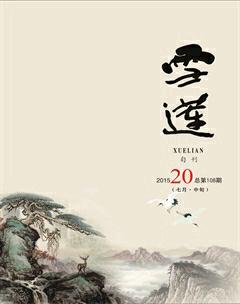中英习语中反映出的文化差异
石薇
【摘 要】不论是在日常生活中,还是在文学作品中,尤其在西方国家,我们都能看见许多习语的运用。本文通过大量举例对比论述了中英习语中所反映的文化差异。为了阐述这一论题,作者分别对习语和文化做了简要分析,通过列举和对比中英习语,作者指出了习语所反映的几个方面的文化差异。最后,作者指出了解中西方文化差异对学习外语和跨文化交际的重要意义,从而使我们在学习语言的过程中注重对不同文化的理解,让我们在理解文化的基础上更好的撑握和有效的运用语言,特别是在跨文化交流中,达到对语言的灵活操作,达到有效而准确的交流目的。
【关键词】文化;习语;语言
1. Brief introduction of the paper
Idiom as a special language form that is particular in meaning、grammatical structure and usage exists in both Chinese and English culture and carries a large amount of cultural information, therefore idiom is closely related to culture. It is the heritage of history and product of cultural evolvement. While different countries have their different idioms, we can know much about cultural differences through learning their idioms and in turn get much better understanding of their idioms.
In this thesis, I intend to analyze the various idioms in Chinese and English in order to prove that different cultural connotation leads to different expression of idioms.
2.1 Definition of idiom and culture
Idioms are fixed group of words or a single word, or even a sentence with a special meaning that cannot be guessed from the literal meaning of its components. They are the product of social custom, which are usually used to depict peoples attributes or characters vividly. With the definition of idioms, we know that it is not easy to understand idioms from their literal meaning. “Language is the carrier container of culture, and is strongly influenced and shaped by culture.” So in order to learn English idioms, one cannot ignore the importance of the cultural meanings they contain.
Chinese famous linguists: Zheng Yanchang and Liu Runqing definite culture as follows: “Culture refers to the total pattern of beliefs customs、institutions、objects and techniques that characterize the life of a human community.”(文化是指一個社会所具有的独特的信仰、习惯、制度、目标和技术的总模式。)
2.2 The relationship between idiom and culture
Goodenough in his Cultural Anthology and Linguistics explained the relationship between language and culture as follows: “Language in one society is one aspect of the social cultures, the relationship between language and culture is the part and the whole, the particularity of this relationship epitomizes as follows: language is the main tool to learn culture, and people gain the whole culture in the course of learning and using language.”
3.1 Differences in diet habits reflected in idioms
Different customs in diet habits can bring lots of words about the diet habits, especially the food. We know that potato is an important food in western countries, so there are lots of idioms expressed with it:
big potato(大人物), small potato(小人物), mouse potato(电脑迷), couch potato(成天看电视的人), hot potato(棘手的问题), and so on.
In China, agriculture is the basic element in people life, so lots of Chinese idioms are about agriculture. Once it was in the agricultural feudal society, the productive forces level was low, so eating to a full belly was the universal issue of people concern at that time. Therefore in Chinese idioms there are many expressions related to “the food”. For instance:
“找碗饭吃”(找工作)looking for the bowl food to eat (looking for a job)” ;“丢了饭碗(失业)lost ones job (unemployment)” “铁饭碗(有一份稳定的工作)the secured job (have a stable work)” ;“吃大锅饭(采取平均分配的原则)have the mess (to adopt equal distribution principle)” ;“茶不思,饭不香 the tea is not thought, the food is not fragrant” and so on.
3.2 Differences in viewing on dog reflected in idioms
For western people, dogs are often associated with good words. They consider dogs to be loyal and dependable friends and think highly of them among all the animals. Dog has become an important part in humanity lives. Some people raise dogs to keep company, some raise dogs to seek pleasure and some also have the seeing-eye dogs to help the blind person and so on. In western literature, the description to dogs is positive, and in western glossary, the words related to dog also have a commendatory meaning. For example: Love me, love my dog(爱屋及乌); Every dog has his day(凡人皆有得意日); Barking dogs seldom bite (吠犬不咬人); A good dog deserves a good bone(立功者受奖); He worked like a dog他工作很卖力); Let sleeping dogs lie (莫惹是非); A living dog is better than a dead lion (死狮不如活狗/凡事講求实际); A son never thinks his mother ugly, and a dog never shuns its owner's home however shabby it is (儿不嫌母丑,狗不嫌家贫); An old dog barks not in vain (老狗不乱咬/老年人做事有经验); top dog(指经奋斗而居高位者;竞争中夺魁者,优胜者); a lucky dog(幸运儿); a dog's life(苦难的日子,潦倒); dog collar(狗项圈); dog days(三伏天); doghouse(失宠)and so on.
In contrast, we Chinese people usually use “dogs” in cursing words to show our scorn to someone. Most of the time what leaves in our impression is that dogs are dirty and filthy. The words related to dog are always derogatory. Using dog to describe a person always has a disdainful meaning. For example: 一人得道,鸡犬升天,狗仗人势,狗腿子,狗眼看人低,狗吃屎,狗急跳墙,狗皮膏药,狗头军师,狗尾续貂,挂羊头卖狗肉and so on.
3.3 Geographical differences reflected in idioms
China is a mainland country, and she has abundant mountains and rivers. So her people life has great close relationship to the land、famous mountains and rivers. There are some idioms originated from them. For examples:“四体不勤,五谷不分”“瑞雪兆丰年”“有眼不识泰山”and so on.
While England is surrounded by the sea, almost every aspect of people life relates to the sea. A lot of idioms are related to the sea、aquatic product and navigation. Some examples can be taken here: “all at sea(没有主意)” “as close as an oyster(守口如瓶)” “cast an anchor to windward(未雨绸缪)” “to grow with the stream(随波逐流)” “to rest on ones oars(暂是歇一歇) ”“to keep ones head above water(奋力图存)”and so on.
4. Conclusion
Today, a large number of idioms are widely used in the daily life in western countries. It is very necessary for us to learn these idioms. As idioms are the parts of culture, the ability to understand them is very important to successful communication in cross-cultural communication. To know the cultural differences the idioms reflect can help us understand and grasp the essence of idioms more effectively. So in order to communicate with foreigners more fluently, the study of the relationship between the idiom and culture is significant and promising.
参考文献:
[1]Goodenough, W. Cultural Anthropology and Linguistics [A].P.Ctarvin ed.Washington: Georgetown University Press,1957.
[2]Matsumoto,David.Culture and Modern Life.Brooks/Cole Publishing Company,2001.
[3]Michael Ashby. Oxford Advanced Learners English-Chinese Dictionary ed.6, Oxford University Press.2004:873-B19.
[4]Reynolds,Sana and Deborah Valentine.Guide to Cross-Cultural Communication. Prentice Hall. 2004:59-65.
[5]Yang zijian. English-Chinese Comparative Study and Translation.Shanghai foreign language and teaching Press: 2002.
[6]余洪紅,徐晓梅.析英汉习语的文化特征[J].淮阴工学院学报,2005,12(6):32-33.
[7]沈掌荣.汉英语言中的文化差异[J].浙江海洋学院学报.1999,6(2):48.
[8]秦忠益.关于习语的文化差异及其翻译[J].吕梁高等专科学校学报,2006,3(1):32.

